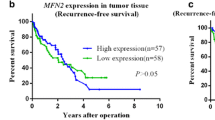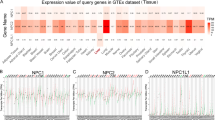Abstract
NADPH oxidase DUOX1, DUOX2, and NOX4 have recently been gained considerable concerns, owing to the fact that they involve in reactive oxygen species-induced genetic and epigenetic alternations of human carcinogenesis and serve as biomarkers in several cancers. Whether they predict survival in hepatocellular carcinoma (HCC) is still uncertain. Here, we detected the expressions of DUOX1, DUOX2, and NOX4 in one normal liver cell line, seven HCC cell lines, 30 non-cirrhotic normal liver tissues, and 107 paired HCC tissues using reverse transcription–polymerase chain reaction. The correlations of genes expression with prognoses were analyzed. DUOX1 was expressed at high levels in MHCC-97H and MHCC-97L, but at low levels in Bel-7402. In contrast to low expression level at SMMC-7721, DUOX2 was expressed at considerably high levels in MHCC-97H and MHCC-97L. The transcript of NOX4 was only detected in SMMC-7721. All the 30 normal liver tissues failed to express the three candidate markers. Compared with adjacent non-neoplastic tissues, DUOX1, DUOX2, and NOX4 were expressed at higher frequencies in tumor specimens. Both univariate and multivariate analyses revealed that elevated expression of DUOX1 or DUOX2 predicted poorer recurrence-free survival and overall survival. No such significance trend regarding NOX4 predictive value in survival, however, was seen in univariate analysis. These results suggested DUOX1 and DUOX2, but not NOX4, could predict HCC prognoses after hepatectomy.


Similar content being viewed by others
Abbreviations
- HCC:
-
Hepatocellular carcinoma
- RT–PCR:
-
Reverse transcription–polymerase chain reaction
- ROS:
-
Reactive oxygen species
- DUOX :
-
Dual oxidase
- NOX4 :
-
NADPH oxidase 4
- GGT:
-
Gamma-glutamyltransferase
- AFP:
-
α-Fetoprotein
- HBsAg:
-
Hepatitis B surface antigen
References
Jemal A, Bray F, Center MM, Ferlay J, Ward E, Forman D. Global cancer statistics. CA Cancer J Clin. 2011;61:69–90.
El-Serag HB, Rudolph KL. Hepatocellular carcinoma: epidemiology and molecular carcinogenesis. Gastroenterology. 2007;132:2557–76.
Altekruse SF, McGlynn KA, Reichman ME. Hepatocellular carcinoma incidence, mortality, and survival trends in the united states from 1975 to 2005. J Clin Oncol. 2009;27:1485–91.
Befeler AS, Di Bisceglie AM. Hepatocellular carcinoma: diagnosis and treatment. Gastroenterology. 2002;122:1609–19.
Trachootham D, Alexandre J, Huang P. Targeting cancer cells by ROS-mediated mechanisms: a radical therapeutic approach? Nat Rev Drug Discov. 2009;8:579–91.
Diehn M, Cho RW, Lobo NA, Kalisky T, Dorie MJ, Kulp AN, et al. Association of reactive oxygen species levels and radioresistance in cancer stem cells. Nature. 2009;458:780–3.
Brown DI, Griendling KK. Nox proteins in signal transduction. Free Radic Biol Med. 2009;47:1239–53.
Nauseef WM. Biological roles for the NOX family NADPH oxidases. J Biol Chem. 2008;283:16961–5.
Paik YH, Iwaisako K, Seki E, Inokuchi S, Schnabl B, Osterreicher CH, et al. The nicotinamide adenine dinucleotide phosphate oxidase homologues NOX1 and NOX2/gp91phox mediate hepatic fibrosis in mice. Hepatology. 2011;53:1730–41.
Ishikawa K, Takenaga K, Akimoto M, Koshikawa N, Yamaguchi A, Imanishi H, et al. Ros-generating mitochondrial DNA mutations can regulate tumor cell metastasis. Science. 2008;320:661–4.
Garrido-Urbani S, Jemelin S, Deffert C, Carnesecchi S, Basset O, Szyndralewiez C, et al. Targeting vascular NADPH oxidase 1 blocks tumor angiogenesis through a PPARalpha mediated mechanism. PLoS One. 2011;6:e14665.
Schumacker PT. SIRT3 controls cancer metabolic reprogramming by regulating ROS and HIF. Cancer Cell. 2011;19:299–300.
Ushio-Fukai M, Nakamura Y. Reactive oxygen species and angiogenesis: NADPH oxidase as target for cancer therapy. Cancer Lett. 2008;266:37–52.
Lee JK, Edderkaoui M, Truong P, Ohno I, Jang KT, Berti A, et al. NADPH oxidase promotes pancreatic cancer cell survival via inhibiting JAK2 dephosphorylation by tyrosine phosphatases. Gastroenterology. 2007;133:1637–48.
Maranchie JK, Zhan Y. Nox4 is critical for hypoxia-inducible factor 2-alpha transcriptional activity in von Hippel–Lindau-deficient renal cell carcinoma. Cancer Res. 2005;65:9190–3.
Kumar B, Koul S, Khandrika L, Meacham RB, Koul HK. Oxidative stress is inherent in prostate cancer cells and is required for aggressive phenotype. Cancer Res. 2008;68:1777–85.
Yamaura M, Mitsushita J, Furuta S, Kiniwa Y, Ashida A, Goto Y, et al. NADPH oxidase 4 contributes to transformation phenotype of melanoma cells by regulating G2-M cell cycle progression. Cancer Res. 2009;69:2647–54.
Moon EJ, Sonveaux P, Porporato PE, Danhier P, Gallez B, Batinic-Haberle I, et al. NADPH oxidase-mediated reactive oxygen species production activates hypoxia-inducible factor-1 (HIF-1) via the ERK pathway after hyperthermia treatment. Proc Natl Acad Sci U S A. 2010;107:20477–82.
Xia C, Meng Q, Liu LZ, Rojanasakul Y, Wang XR, Jiang BH. Reactive oxygen species regulate angiogenesis and tumor growth through vascular endothelial growth factor. Cancer Res. 2007;67:10823–30.
Pulcrano M, Boukheris H, Talbot M, Caillou B, Dupuy C, Virion A, et al. Poorly differentiated follicular thyroid carcinoma: prognostic factors and relevance of histological classification. Thyroid. 2007;17:639–46.
Luxen S, Belinsky SA, Knaus UG. Silencing of DUOX NADPH oxidases by promoter hypermethylation in lung cancer. Cancer Res. 2008;68:1037–45.
Huang P, Qiu J, Li B, Hong J, Lu C, Wang L, et al. Role of Sox2 and Oct4 in predicting survival of hepatocellular carcinoma patients after hepatectomy. Clin Biochem. 2011;44:582–9.
Tian J, Tang ZY, Ye SL, Liu YK, Lin ZY, Chen J, et al. New human hepatocellular carcinoma (HCC) cell line with highly metastatic potential (MHCC97) and its expressions of the factors associated with metastasis. Br J Cancer. 1999;81:814–21.
Mochizuki T, Furuta S, Mitsushita J, Shang WH, Ito M, Yokoo Y, et al. Inhibition of NADPH oxidase 4 activates apoptosis via the AKT/apoptosis signal-regulating kinase 1 pathway in pancreatic cancer PANC-1 cells. Oncogene. 2006;25:3699–707.
Lu SN, Wang JH, Liu SL, Hung CH, Chen CH, Tung HD, et al. Thrombocytopenia as a surrogate for cirrhosis and a marker for the identification of patients at high-risk for hepatocellular carcinoma. Cancer. 2006;107:2212–22.
Belghiti J. Resection and liver transplantation for HCC. J Gastroenterol. 2009;44 Suppl 19:132–5.
Bedard K, Krause KH. The NOX family of ROS-generating NADPH oxidases: physiology and pathophysiology. Physiol Rev. 2007;87:245–313.
Acknowledgments
This work was supported by grants from the National Natural Science Foundation of China (30872489 and 30972916). The authors thank all the patients who participated in this study.
Conflicts of interest
None
Author information
Authors and Affiliations
Corresponding author
Additional information
Can-Liang Lu and Ji-Liang Qiu contributed equally to this work.
Rights and permissions
About this article
Cite this article
Lu, CL., Qiu, JL., Huang, PZ. et al. NADPH oxidase DUOX1 and DUOX2 but not NOX4 are independent predictors in hepatocellular carcinoma after hepatectomy. Tumor Biol. 32, 1173–1182 (2011). https://doi.org/10.1007/s13277-011-0220-3
Received:
Accepted:
Published:
Issue Date:
DOI: https://doi.org/10.1007/s13277-011-0220-3




